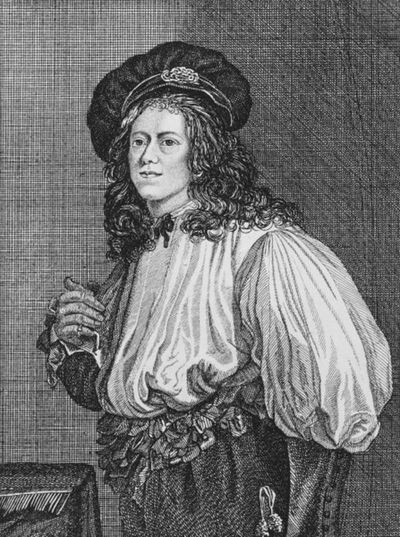Annotation:Jacob Hall's Jig (2): Difference between revisions
No edit summary |
m Text replacement - "garamond, serif" to "sans-serif" |
||
| Line 1: | Line 1: | ||
=='''Back to [[{{BASEPAGENAME}}]]'''== | =='''Back to [[{{BASEPAGENAME}}]]'''== | ||
---- | ---- | ||
<p><font face=" | <p><font face="sans-serif" size="4"> | ||
'''JACOB HALL'S JIG [2]'''. English, Jig (6/4 time). D Minor. Standard tuning (fiddle). AAB. The melody was first published by Henry Playford in the 9th edition of the '''Dancing Master''' [http://www.izaak.unh.edu/nhltmd/indexes/dancingmaster/] (1695), and in all subsequent editions through until the last of the series, the 18th edition, published in London by John Young in 1728. "Jacob Hall's Jig" was also published by John Walsh in his '''Compleat Country Dancing Master''' (London, 1718). The longways dance was performed in the movie Emma (1996), starring Gwyneth Paltrow. [[File:jacobhall.jpeg|400px|thumb|right|Portrait of a man thought to be Jacob Hall, by Van Oost]] | '''JACOB HALL'S JIG [2]'''. English, Jig (6/4 time). D Minor. Standard tuning (fiddle). AAB. The melody was first published by Henry Playford in the 9th edition of the '''Dancing Master''' [http://www.izaak.unh.edu/nhltmd/indexes/dancingmaster/] (1695), and in all subsequent editions through until the last of the series, the 18th edition, published in London by John Young in 1728. "Jacob Hall's Jig" was also published by John Walsh in his '''Compleat Country Dancing Master''' (London, 1718). The longways dance was performed in the movie Emma (1996), starring Gwyneth Paltrow. [[File:jacobhall.jpeg|400px|thumb|right|Portrait of a man thought to be Jacob Hall, by Van Oost]] | ||
<br> | <br> | ||
| Line 10: | Line 10: | ||
<br> | <br> | ||
</font></p> | </font></p> | ||
<p><font face=" | <p><font face="sans-serif" size="4"> | ||
''Source for notated version'': | ''Source for notated version'': | ||
<br> | <br> | ||
<br> | <br> | ||
</font></p> | </font></p> | ||
<p><font face=" | <p><font face="sans-serif" size="4"> | ||
''Printed sources'': Barlow ('''Complete Country Dance Tunes from Playford's Dancing Master'''), 2005; No. 326, p. 79. Barnes ('''English Country Dance Tunes, vol. 2'''), 2005; p. 65. | ''Printed sources'': Barlow ('''Complete Country Dance Tunes from Playford's Dancing Master'''), 2005; No. 326, p. 79. Barnes ('''English Country Dance Tunes, vol. 2'''), 2005; p. 65. | ||
<br> | <br> | ||
<br> | <br> | ||
</font></p> | </font></p> | ||
<p><font face=" | <p><font face="sans-serif" size="4"> | ||
''Recorded sources'': <font color=teal></font> | ''Recorded sources'': <font color=teal></font> | ||
</font></p> | </font></p> | ||
Latest revision as of 13:28, 6 May 2019
Back to Jacob Hall's Jig (2)
JACOB HALL'S JIG [2]. English, Jig (6/4 time). D Minor. Standard tuning (fiddle). AAB. The melody was first published by Henry Playford in the 9th edition of the Dancing Master [1] (1695), and in all subsequent editions through until the last of the series, the 18th edition, published in London by John Young in 1728. "Jacob Hall's Jig" was also published by John Walsh in his Compleat Country Dancing Master (London, 1718). The longways dance was performed in the movie Emma (1996), starring Gwyneth Paltrow.

Jacob Hall [2] was a 17th century tight-rope dancer and acrobat whose agile performances delighted diarist Samuel Pepys and others of the era. He was a some-time lover of the mistress of Charles II, Lady Castlemain, the Duchess of Cleveland, who took revenge on the king for neglecting her.
Source for notated version:
Printed sources: Barlow (Complete Country Dance Tunes from Playford's Dancing Master), 2005; No. 326, p. 79. Barnes (English Country Dance Tunes, vol. 2), 2005; p. 65.
Recorded sources:
